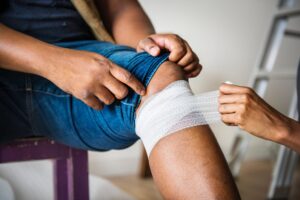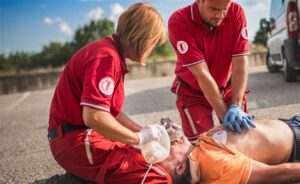Back to: Physical and Health Education JSS 2
Welcome to class!
In today’s class, we shall be talking about the importance of first aid treatment. I am trusting you will enjoy this class!
First Aid and Safety Education education – Importance of First Aid Treatment

Imagine you’re on a hike, enjoying the fresh air and breathtaking scenery, when suddenly, your friend twists their ankle. Panic sets in. You’re miles from the hospital, and help seems far away. What do you do? This is where first aid comes in. It’s not just about bandages and antiseptic wipes; it’s the art of knowing how to react calmly and effectively in an emergency, potentially saving lives or minimizing the severity of injuries.
Importance of First Aid Treatment:
Preserves life: In critical situations, immediate and correct first aid can be the difference between life and death. Severe bleeding, choking, or heart attacks require quick intervention, and knowing basic life-saving skills can buy precious time until medical professionals arrive.
Prevents further harm: Even minor injuries can worsen if not treated properly. Knowing how to clean wounds, immobilize fractures, and manage burns can prevent complications, infections, and long-term damage.
Reduces anxiety and fear: Witnessing an accident or injury can be incredibly stressful. Having first aid knowledge can empower you to act calmly and effectively, bringing comfort to the injured and yourself.
Builds confidence and self-reliance: Knowing you can handle emergencies fosters a sense of confidence and self-sufficiency, making you a valuable asset in any situation, whether on the field, at home, or in the community.
Essential First Aid Skills:

Basic life support: CPR and AED (automated external defibrillator) training can equip you to handle situations of cardiac arrest or respiratory failure, potentially saving lives.
Wound care: Knowing how to clean, bandage, and dress wounds properly promotes healing and prevents infections.
Bleeding control: Applying direct pressure, elevating the wound, and using tourniquets in extreme cases can stop severe bleeding and prevent shock.
Fracture and sprain management: Immobilizing fractures and sprains with slings, splints, or braces minimizes pain and prevents further damage.
Burns and heat stroke: Understanding how to cool burns and manage heat stroke symptoms can prevent serious complications.
Poison control: Knowing how to identify and manage poisoning emergencies, including calling emergency services and administering basic first aid, can be crucial.
First aid isn’t just about technical knowledge; it’s about awareness, responsibility, and critical thinking. It’s about assessing the situation calmly, prioritizing actions, and knowing when to seek professional help. It’s about being prepared for the unexpected and making a difference when it matters most.
First aid education is not just a college requirement; it’s an investment in your own safety and the well-being of those around you. It’s a lifelong skill that can empower you to act with confidence and potentially save lives. Remember, knowledge is power, and in the realm of first aid, it can be the power to heal and protect. So, embrace this knowledge, hone your skills, and become a valuable asset in the face of unexpected challenges.
We have come to the end of today’s class. I hope you enjoyed the class!
In the next class, we shall be discussing Content of a good first aid box.
In case you require further assistance or have any questions, feel free to ask in the comment section below, and trust us to respond as soon as possible. Cheers!
Question Time:
- Scenario-based: You’re on a camping trip when your friend cuts their hand deeply on a sharp rock. Describe the steps you would take to provide first aid for the wound.
- True or False: Applying pressure to a burn will worsen the injury. (
- Multiple Choice: What is the best way to control bleeding from a severe leg wound? (a) Apply a tourniquet (b) Elevate
- Matching: Match the following first aid terms with their definitions: (a) CPR, (b) AED, (c) Splint, (d) Heimlich Maneuver) – (i) Used to restart a stopped heart (ii) Device that delivers an electric shock to restore normal heart rhythm (iii) Stabilizes a broken bone (iv) Abdominal thrusts to dislodge a swallowed object)
